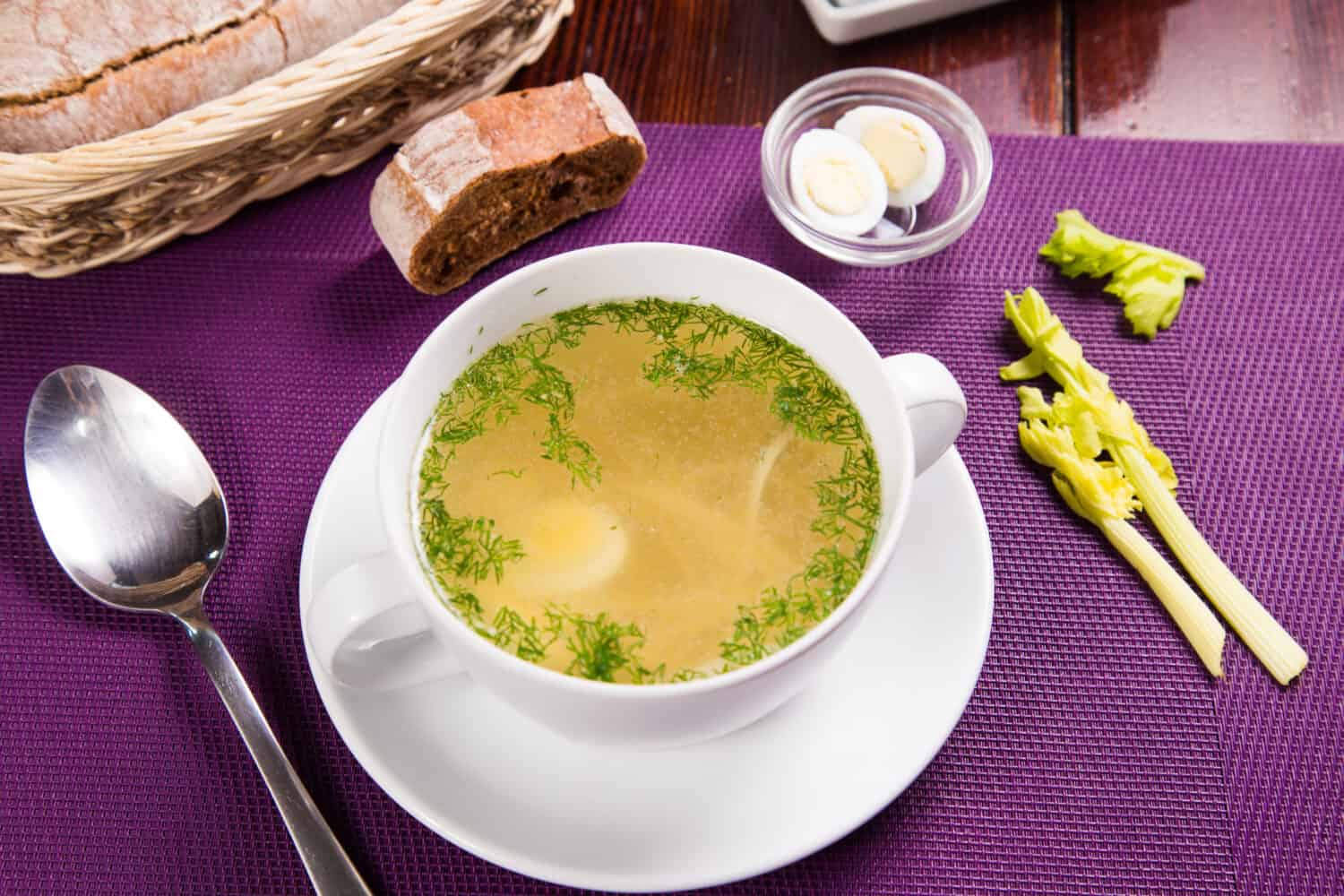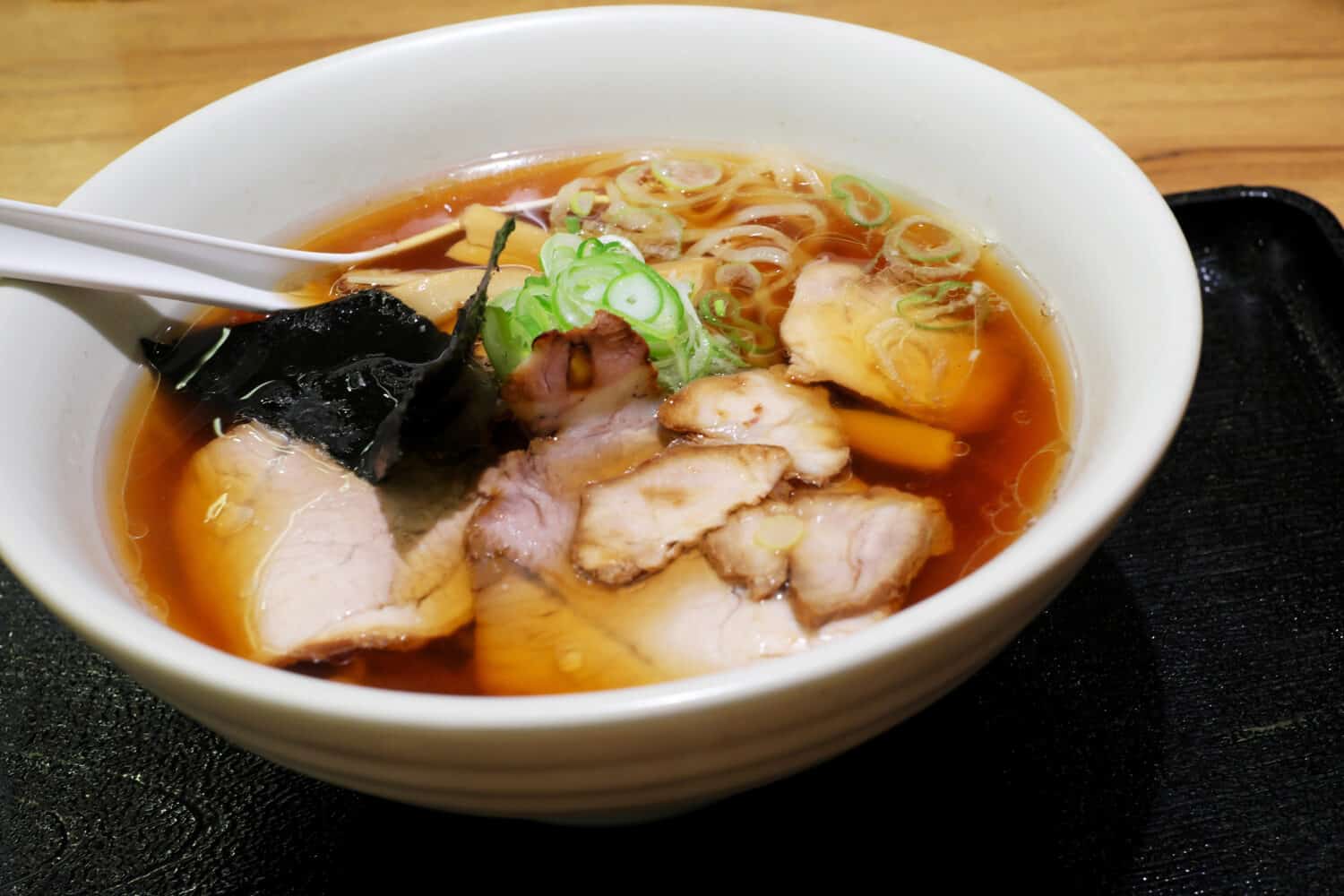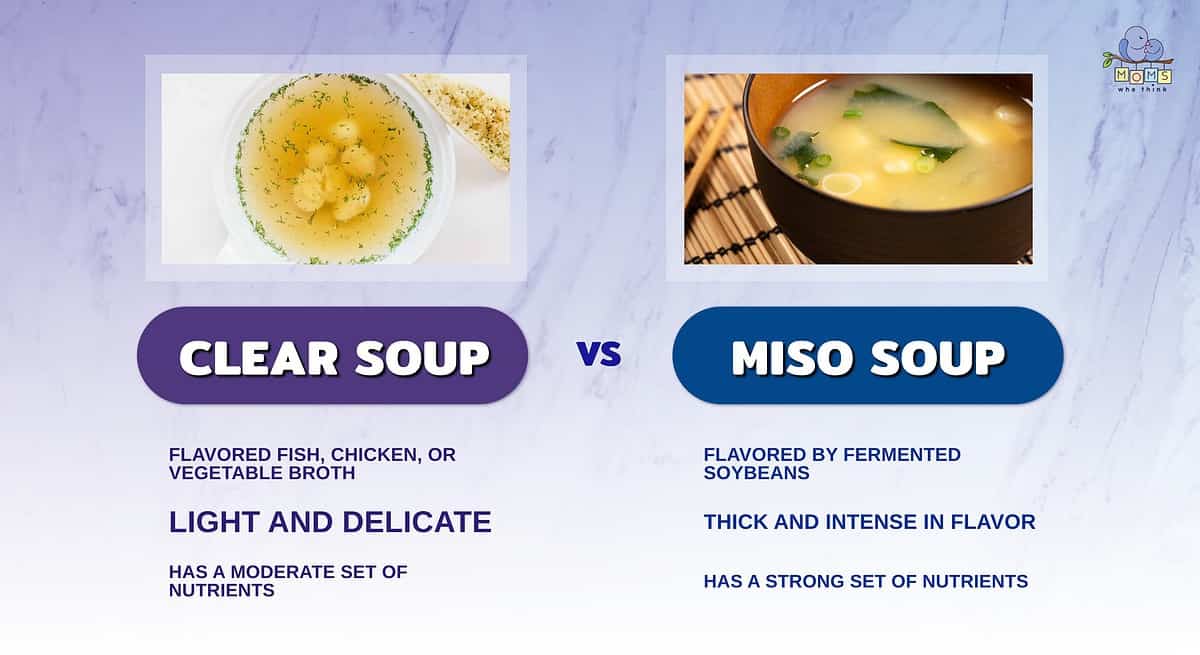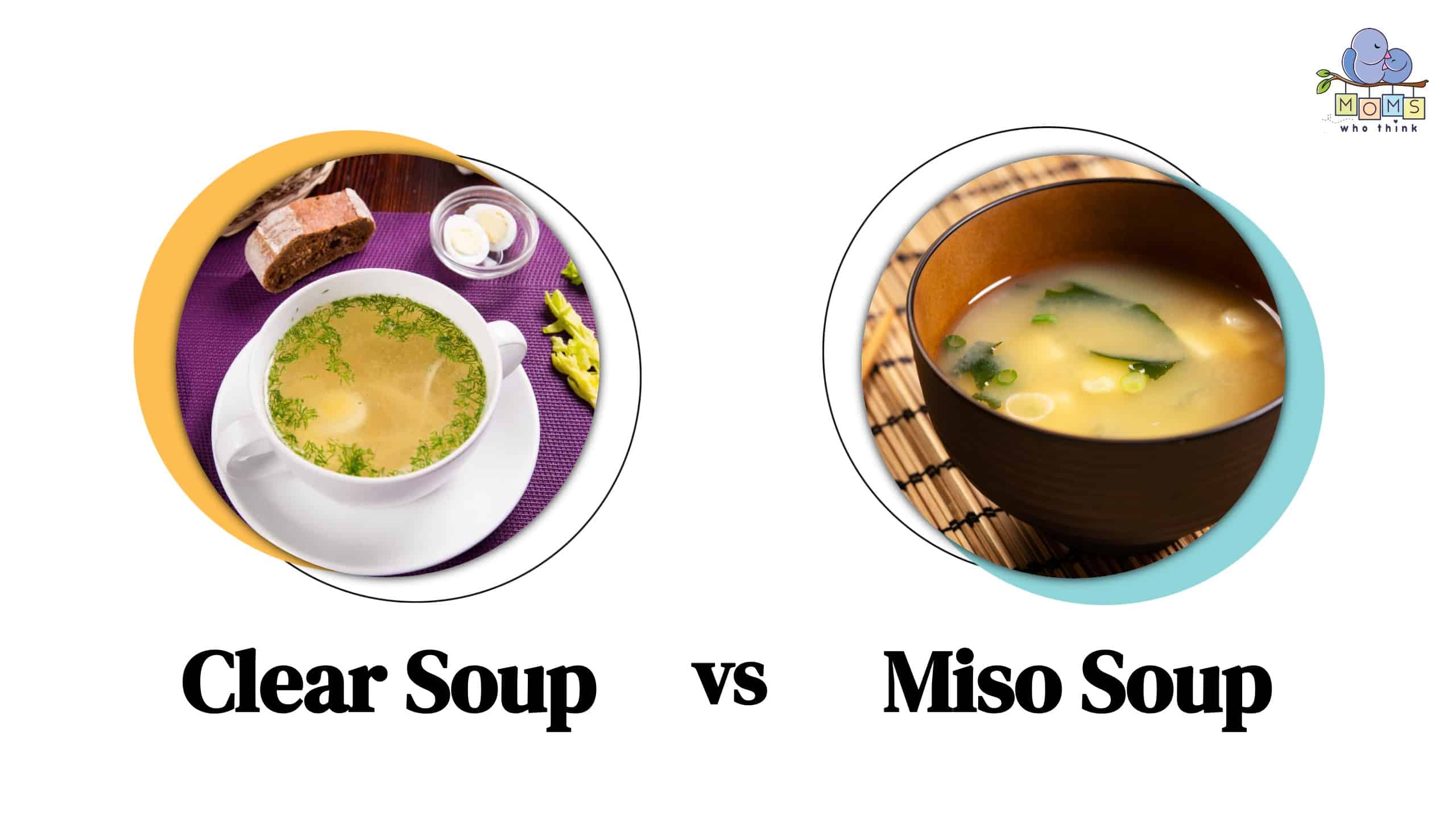Clear soup vs. miso soup — are they the same thing? You can prepare clear soup by simmering ingredients, while you can make miso soup by adding Japanese ingredients to dashi broth. There are some similarities, but the two dishes differ in more ways. This article will go in-depth about their differences, similarities, history, and how to prepare these two types of soup.
Differences Between Clear Soup and Miso Soup
The most important difference between clear soup and miso soup is that miso soup is thicker, with more flavor. Clear soup has no solid ingredients and is a broth with flavors that can include fish, chicken, or vegetables, whereas miso soup gets its distinct flavor from fermented soybeans.
Let's explore their differences in ingredients, taste, texture, and health benefits in more detail.
Ingredients
The ingredients used in clear soup and miso soup are significantly different. You can make clear soup by simmering its ingredients in water and straining the liquid to make a favorable broth. You can make miso soup from a dashi broth with miso paste, seaweed, green onions, and tofu.
Taste and Texture
There are big flavor and texture differences between clear soup and miso soup. Miso soup is thick and flavorful, whereas clear soup is light and delicate. Clear soup is thin and watery, but miso soup is slightly thick and smooth.
Different Health Benefits
The nutritional profiles and potential health advantages of miso soup and clear soup differ. Miso soup recipes include fermented soybean paste, which helps improve nutrient absorption and provides antioxidants and microorganisms that support gut health and immunity. Clear soup, on the other hand, can provide vitamins and minerals from vegetable broth and protein from meat or fish broth. Still, it might not have the same ability to boost nutrient absorption and digestive and immune health as miso soup.
What is Clear Soup?

Clear soup is a great appetizer for any occasion.
©Chatham172/Shutterstock.com
Clear soup, often known as consommé, is a liquid soup with no solid ingredients. Instead, it gets prepared by cooking poultry, meat, or fish with vegetables and herbs to create a tasty, nutritious broth. After that, the soup gets strained to remove any solid ingredients, producing a translucent liquid. Clear soups are excellent light appetizers.
European food, especially French food, is where clear soup comes from. “Consommé” comes from the French word “consumer,” which means “to use up” or “to eat.” This likely originates from the way people used to make broth by using leftover ingredients. For centuries, European cooking has used “clarifying” soup to make a clear liquid. Clear soup came from France in the Middle Ages. It became famous in the 18th and 19th centuries when French cooking advanced.
Making Clear Soup Healthier
Here are some ways to make your clear soup healthier while retaining its delicious flavor.
- Choose lean proteins: Using lean proteins to make your soup can reduce the fat content in your broth. There are many potential health benefits from not eating so much fat, such as lowering the risk of heart disease, obesity, diabetes, and multiple sclerosis.
- Use more vegetables: Adding a large variety of vegetables to make your broth not only adds flavor but also increases the nutritional content of your soup. Vegetables contain nutrients like potassium, vitamins A, E, and C, fiber, and folate, which can help maintain healthy blood pressure, reduce cholesterol, and protect against infection.
- Reduce sodium: High salt intake could result in health problems such as high blood pressure. To reduce sodium, use low-sodium or homemade broth and avoid using too much salt. Instead, add fresh herbs, spices, or a squeeze of lemon juice to improve the flavor.
- Remove excess fat: After making the soup, let it cool and then skim off any fat seen on the top. This will help cut down on the amount of fat in the soup.
- Use fresh herbs and spices: Fresh herbs and spices offer flavor without adding extra calories. They also have antioxidants that can reduce the risk of cancer, vision loss, and many other chronic conditions.
Changing these things in your soup will greatly enhance your health while still providing a flavorful meal that anyone can enjoy.
What is Miso Soup?
Miso soup is a popular Japanese soup cooked with a dashi stock base from simmering kelp and dried fish flakes. Miso, a paste prepared from fermented soybeans, provides the soup its distinct flavor. This soup is made with tofu, green onions, and seaweed, but you can add other ingredients. Miso soup gets served as a side dish in Japan.
Miso soup has a unique role in Japanese culture. It is an essential part of Japanese food and a symbol of the country's food culture. Miso soup gets served as a side dish, and people like it for breakfast, lunch, or dinner since it is warm and cozy. In Japan, having miso soup for breakfast helps detoxify the body and keep it healthy. In addition, the soup gets served at special events and traditional Japanese tea rituals.
Making Miso Soup Healthier
Here are a few ways to create a healthy and flavorful miso soup.
- Choose low-sodium miso: There can be a lot of sodium in miso paste, leading to health problems like high blood pressure. To cut down on salt, use a low-sodium miso paste or lessen the amount of miso in your soup.
- Include seaweed: Including seaweed in your miso soup has many health benefits and adds flavor to your soup. In addition, seaweed contains nutrients and antioxidants that can support thyroid function, reduce your chances for heart disease and diabetes, and fiber that supports your gut health.
- Reduce added fats: Use extra oils or fats moderately if your miso soup recipe calls for them. When using oils, choose heart-healthy fats like sesame oil or olive oil.
- Use whole grains: Choose healthful grains like brown rice, barley, or quinoa if you want to add grains to your miso soup. These grains are more nutritious and higher in fiber.
By following these suggestions, you can make a healthier miso soup without sacrificing its great flavor or comforting features.

You can add many ingredients to miso soup to make a flavorful dish.
©FotoFeast/Shutterstock.com
Similarities Between Clear Soup and Miso Soup
Despite their differences in ingredients and origins, clear soup and miso soup have certain things in common. Here are some similarities between the two:
- Broth-Based: Both soups are broth-based, which means that they are made mainly by boiling ingredients in water to bring out their flavors.
- Comfort Food: These soups are comfort food in their culture. They are warm and relaxing, you can eat this soup as a light appetizer or a side dish.
- Versatility: Clear soup and miso soup are versatile recipes that can be changed to fit each person's tastes. You can make clear soup using many proteins, vegetables, and garnishes.
- Nutritious: Depending on the contents, both soups can be healthy, giving necessary vitamins, minerals, and other nutrients. Clear soups are often low in calories and fat, but miso soup provides probiotics from fermented miso paste and other nutrients from the various ingredients.
The similarities show that despite their unique tastes and cultural backgrounds, clear soup and miso soup have vital characteristics that make them both popular and delightful dishes worldwide.
In Summary

- Miso soup gets its distinct flavor from fermented soybeans, while clear soup can be flavored with seafood, vegetables, or meat.
- Clear soup is thin, light, and delicate, while miso soup is thick with an intense flavor.
- Miso soup has a strong set of nutrients that can boost digestive health. Clear soup has a good set of nutrients, but doesn't offer quite the array of benefits that miso soup does.

Easy Vegetable Soup
Ingredients
- 1 to 2 large cans V-8 juice
- 2 lbs. lean hamburger
- 1 can okra, drained
- 1 can white corn, drained
- 2 (32 oz.) cans mixed vegetables or large bag of frozen vegetables
- 2 to 3 stalks celery, chopped
- 1 to 2 cans stewed tomatoes
- 3 Tablespoons chopped cilantro
- Garlic powder to taste
- Ground pepper to taste
Instructions
- Brown meat, drain. Add V-8 juice and all other ingredients.
- Simmer at least 30 minutes, longer if possible.
- Serve with flour tortillas filled with low fat Mozzarella cheese and heated in the microwave until cheese has melted.
In summary, while originating from different culinary traditions, clear soup and miso soup have distinct characteristics that set them apart. However, they share some commonalities, such as being broth-based, versatile, and nutritious. Both soups have rich histories and cultural significance, and their delicious flavors have made them popular across the globe. By understanding their differences and similarities, one can appreciate the unique qualities of each soup and explore ways to make them healthier while still enjoying its comforting nature. Ultimately, both clear soup and miso soup provide a delicious and satisfying experience that you can tailor to your individual preferences and dietary needs.


